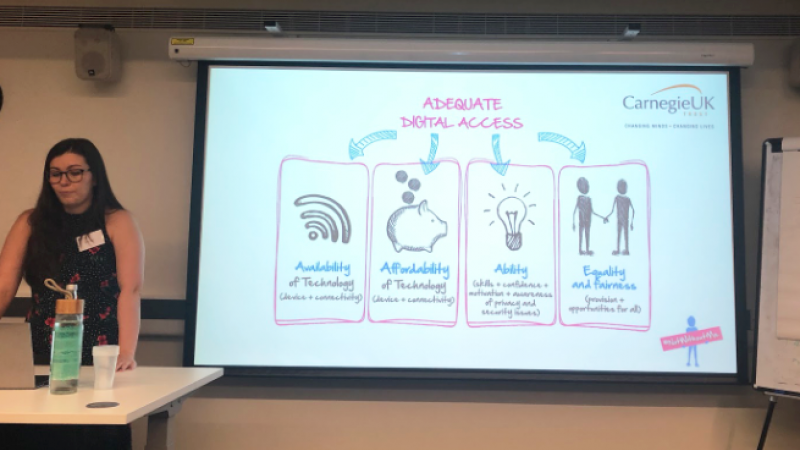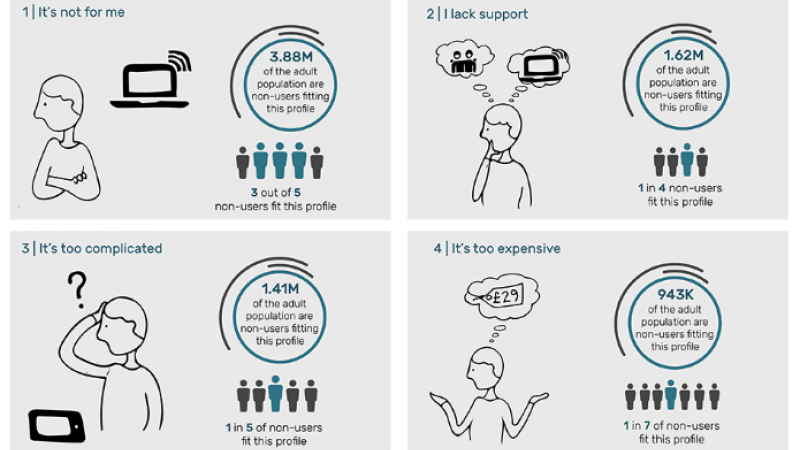Global perspectives on digital inclusion
Jess recounts her experience at the University of Liverpool’s Digital Inclusion Policy and Research conference.
With over 3.8 billion people across the world not online, the issue of digital inclusion is a global one. As the world becomes more connected, technology becomes faster and more integrated into our lives, and more governments require online interaction for essential services, the need to ensure no one gets left behind is an international challenge.
It requires different approaches, different organisations and different input from public servants, academics, local service providers and communities all across the world.
In Australia, being so far away from so many other parts of the world, we can sometimes feel a bit removed from what is happening in other countries despite our ability to be globally connected. So, it was with great interest that I took the opportunity to attend and present at the University of Liverpool’s Digital Inclusion Policy and Research conference in London on 18 June, organised by Professor Simeon Yates and team.
It was also a wonderful opportunity for me to present alongside colleagues from Good Things Foundation UK, Lauren Quinn and Emily Redmond, and to share the work that we are doing across three different countries: UK, Kenya and Australia.
Hearing so many interesting pieces of work all focussed on supporting digital inclusion across the world was inspiring to me.
As with any conference, it’s just not possible to see and hear every presentation, so I’ve selected a few from the day to highlight here.
Digital Inclusion in Latin America
The first keynote presentation Digital Inequality in Latin American Elections: Using Technology to Upturn Power Dynamics was from Renata Avila and Auska Ovando at Ciudadania Inteligente. The staff at Ciudadania Inteligente have been working to strengthen democracy in Latin America using DigitalHubs for elections. Coming from Australia where we have compulsory voting, I just didn’t think about the significant impact the digital divide would have on democracy itself. But of course, in countries such as Ecuador, Chile and Guatemala where digital connectivity is low, literacy rates are low, corruption and violence against those who challenge the status quo is high, the opportunity for everyday people to understand and participate in the political process is a huge challenge. As Renata Avila suggested, the digital divide = a weaker democracy in many Latin American countries.
It was fascinating to hear about how Ciudadania Inteligente is using blended methods of digital platforms and face-to-face workshops to build digital literacy, content and connection to the electoral process, helping to promote local people as candidates and connect local people with politicians to be able to ask questions and know more about what they stand for. This approach in Guatemala saw a local Indigenous woman achieve 10% of the vote due to her focus on positivity rather than negativity and corruption, a hashtag #Ichoosedignity, and the support of many young people.
It was inspiring to hear about this work and the impact that a small team across 6 countries is having with the aim of improving people’s lives through a blended digital face-to-face approach; the same kind of focus that we at Good Things Foundation promote.
Working with digitally excluded young people
Anna Grant from the Carnegie UK Trust talked about their #NotWithoutMe project where they have been working with vulnerable young people to better understand the reasons for and conditions of digital exclusion. Many people expect that digital exclusion in western countries is an issue for older people and that young people are all digital natives, so many government strategies and approaches don’t have a focus on young people when talking about learning basic digital skills. But, as Anna described, vulnerable young people, definitely do experience digital exclusion. As a result, unlike in Australia where we talk about digital inclusion as having three key areas: Access, Affordability and Ability, they have added Equality and Fairness to ensure that digital inclusion strategies include a focus on social justice, highlighting that digital exclusion exacerbates social disadvantage. Young people who don’t have access to technology miss out on things as simple as streaming tv, that highlights their otherness and reinforces their disadvantage. She talked about digital literacy for young people needing to not only be about the ability to use technology, but the skills related to using them, like knowing how to write an email. Although young people may have an email address and can send an email, what to put in that email when applying for a job is the big issue that may prevent them from securing work successfully.
Carnegie Trust UK’s research recommended that digital skills be built into the support of young people, something we at Good Things Foundation have been advocating for across our Networks in the UK, Australia and Kenya.

The motivation of non-users of the internet
In the same session, Lauren Quinn presented the findings from Good Things Foundation’s research with Professor Simeon Yates on Motivational Barriers of non-users of the internet. This research, funded by BT, aimed to better understand the specific reasons people in the UK give for being offline, in greater depth and granularity than currently available research.
What they found were four key reasons that are highlighted by the statements below:
- It’s not for me – the group in which the strongest predictive links existed with people’s demographics and circumstances.
- I lack support – this could be access to the support they feel they need in order to get online, or the actual devices required to do this
- It’s too complicated – this reason may be used so as to mask their own abilities if they do not have the skills to go online. These are not just basic digital skills but also an understanding of how the internet works. Importantly it may include the critical skills to judge digital content to stay safe online.
- It’s too expensive – this is related to the affordability of devices as well as connection costs for running these devices.

It’s fascinating research that highlights in more detail some of the complexities of people’s behaviour in relation to technology.
Power Up
The focus on new research and programs continued the next day as I attended the launch of the Power Up initiative in London. Power Up, a new Good Things Foundation program funded by JP Morgan Chase Foundation, is focussed on digital and economic inclusion. You can read more in our Group CEO Helen Milner’s blog on the subject, We need to get ready for a digital economy, which highlights the fact that today, better digital capabilities are vital not just for people looking for work, but for the entire economy.
The research that backs this initiative has focused on three key areas:
- Improving digital skills for small and micro businesses (PDF)
- Improving digital skills for employability (PDF)
- Improving financial capability through digital skills (PDF)
It’s an exciting initiative for Good Things Foundation and one that I was thrilled to be at the launch of because there are so many things we can learn from this research for our work in Australia too.
That is one of the amazing things about working for Good Things Foundation – being involved in conversations that are about new, evidence-based, people-focussed work that aim to improve lives on a local and a global scale. There’s so much to do, so I hope that we can continue not only the conversations, but the partnerships and actions, that will ensure technology is an enabler across the world not a reason behind greater social and economic division.
